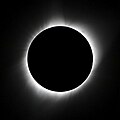| Total eclipse | |
| Gamma | −0.0075 |
|---|---|
| Magnitude | 1.0492 |
| Maximum eclipse | |
| Duration | 249 s (4 min 9 s) |
| Coordinates | 11°06′S135°54′W / 11.1°S 135.9°W |
| Max. width of band | 163 km (101 mi) |
| Times (UTC) | |
| Greatest eclipse | 21:18:46 |
| References | |
| Saros | 127 (46 of 82) |
| Catalog # (SE5000) | 9047 |
A total solar eclipse occurred at the Moon's ascending node of orbit on Monday, February 21, 1803, with a magnitude of 1.0492. A solar eclipse occurs when the Moon passes between Earth and the Sun, thereby totally or partly obscuring the image of the Sun for a viewer on Earth. A total solar eclipse occurs when the Moon's apparent diameter is larger than the Sun's, blocking all direct sunlight, turning day into darkness. Totality occurs in a narrow path across Earth's surface, with the partial solar eclipse visible over a surrounding region thousands of kilometres wide. Occurring only about 18 hours before perigee (on February 22, 1803, at 15:00 UTC), the Moon's apparent diameter was larger. [1]
Contents
- Eclipse details
- Eclipse season
- Related eclipses
- Eclipses in 1803
- Metonic
- Tzolkinex
- Half-Saros
- Tritos
- Solar Saros 127
- Inex
- Triad
- Solar eclipses of 1801–1805
- Saros 127
- Metonic series
- Tritos series
- Inex series
- See also
- References
- External links
The path of totality was visible from parts of modern-day Norfolk Island, French Polynesia, Mexico, Florida, and the Bahamas. A partial solar eclipse was also visible for parts of eastern Australia, Oceania, North America, Central America, the Caribbean, and northern South America. [2]





























































































